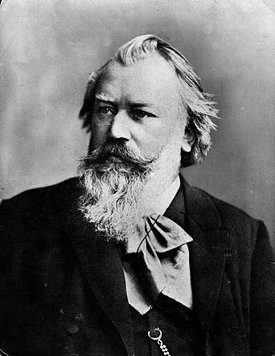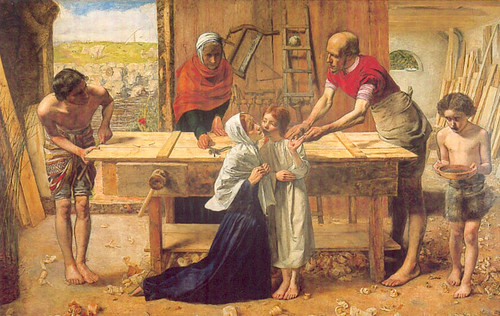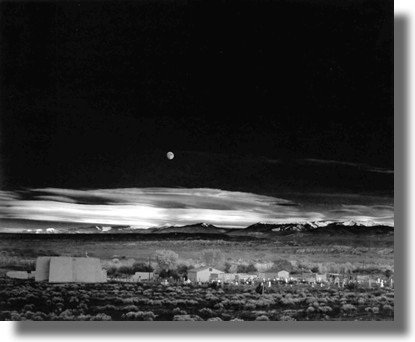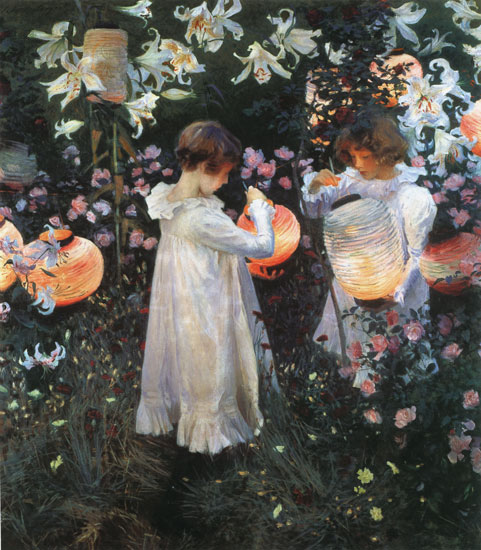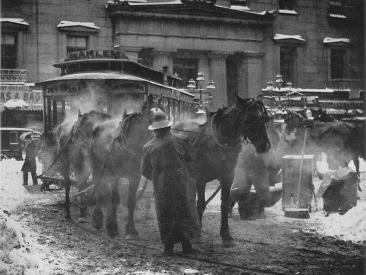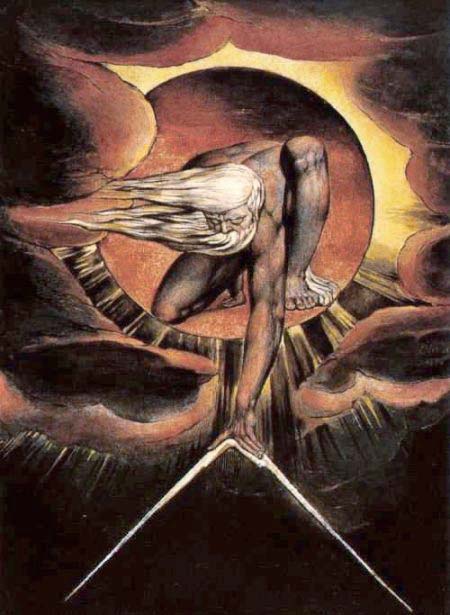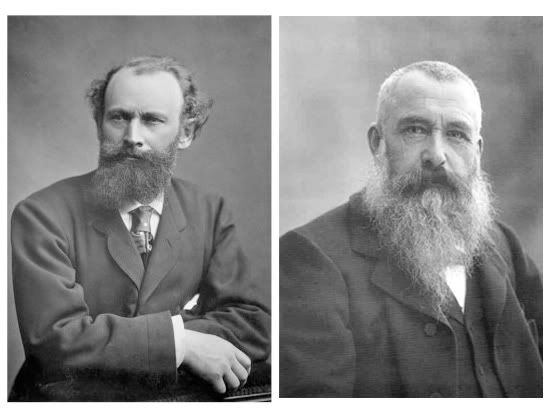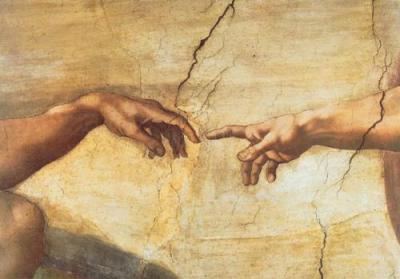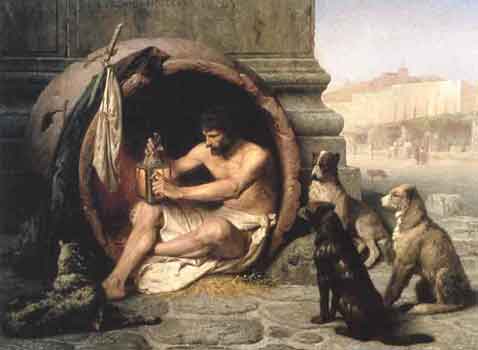Thursday, December 30, 2010
Symphony No. 4 in E minor, Op. 98 -- Brahms
This is the last of Brahms' symphonies. Brahms began working on the piece in 1884, just a year after finishing his Symphony No. 3, and completed it in 1885.
To be fair, I haven't listened to much of Brahms. Each movement in this symphony flows seamlessly from one mood and image to another; it breathes, it almost sighs. It queries, it protests, it exclaims, and it laughs, all the while lilting up and down in a graceful but simple call-and-answer melody with wonderful dynamics—and the very rare chaconne, a characteristically Baroque composition.
Thursday, December 23, 2010
In My Craft or Sullen Art -- Dylan Thomas
In my craft or sullen art
Exercised in the still night
When only the moon rages
And the lovers lie abed
With all their griefs in their arms,
I labour by singing light
Not for ambition or bread
Or the strut and trade of charms
On the ivory stages
But for the common wages
Of their most secret heart.
Not for the proud man apart
From the raging moon I write
On these spindrift pages
Nor for the towering dead
With their nightingales and psalms
But for the lovers, their arms
Round the griefs of the ages,
Who pay no praise or wages
Nor heed my craft or art.
Image Credit: Christ in the House of His Parents, John Everett Millais controversial depiction of Jesus in the carpentry workshop of Joseph.
Monday, December 20, 2010
Blackberrying -- Plath
Nobody in the lane, and nothing, nothing but blackberries,
Blackberries on either side, though on the right mainly,
A blackberry alley, going down in hooks, and a sea
Somewhere at the end of it, heaving. Blackberries
Big as the ball of my thumb, and dumb as eyes
Ebon in the hedges, fat
With blue-red juices. These they squander on my fingers.
I had not asked for such a blood sisterhood; they must love me.
They accommodate themselves to my milkbottle, flattening their sides.
Overhead go the choughs in black, cacophonous flocks ---
Bits of burnt paper wheeling in a blown sky.
Theirs is the only voice, protesting, protesting.
I do not think the sea will appear at all.
The high, green meadows are glowing, as if lit from within.
I come to one bush of berries so ripe it is a bush of flies,
Hanging their bluegreen bellies and their wing panes in a Chinese screen.
The honey-feast of the berries has stunned them; they believe in heaven.
One more hook, and the berries and bushes end.
The only thing to come now is the sea.
From between two hills a sudden wind funnels at me,
Slapping its phantom laundry in my face.
These hills are too green and sweet to have tasted salt.
I follow the sheep path between them. A last hook brings me
To the hills' northern face, and the face is orange rock
That looks out on nothing, nothing but a great space
Of white and pewter lights, and a din like silversmiths
Beating and beating at an intractable metal.
Image Credit: Nude in Sunlight by Renoir
Wednesday, December 15, 2010
The Red Blue Chair -- Reitveld
Originally painted in just black and white, but later re-painted to synchronize with the style of Piet Mondrian. Along with Mondrian, Reitveld was at the forefront of the De Stijl movement, which manifested itself in furniture, painting (below), and architecture.



Sunday, December 12, 2010
Unique Forms of Continuity in Space -- Boccioni

Part of a movement known as Futurism which emphasized speed, motion and power in the context of the modern world. Also check out Dynamism of the Dog by Balla
Thursday, December 9, 2010
The Village Blacksmith -- Longfellow
Under a spreading chestnut tree
The village smithy stands;
The smith, a mighty man is he,
With large and sinewy hands;
And the muscles of his brawny arms
Are strong as iron bands.
His hair is crisp, and black, and long,
His face is like the tan;
His brow is wet with honest sweat,
He earns whate'er he can,
And looks the whole world in the face,
For he owes not any man.
Week in, week out, from morn till night,
You can hear his bellows blow;
You can hear him swing his heavy sledge
With measured beat and slow,
Like a sexton ringing the village bell,
When the evening sun is low.
FUN FACT: In the dystopian novel '1984' by Eric Blair , one location featured is the Chestnut Tree Cafe called the "haunt of painters and musicians. There was no law, not even an unwritten law, against frequenting the Chestnut Tree Cafe, yet the place was somehow ill-omened."
There is a rhyme about the cafe that re-occurs throughout the book:
Under the spreading chestnut tree
I sold you and you sold me
There lie they, and here lie we
Under the spreading chestnut tree
This is considered to be a translation of Longfellow's Poem into Newspeak, the invented language of the novel which is meant to reduce extraneous thought and subtly censor rebellion so that no one could possibly produce a thought diverging from the principles of 'Ingsoc' or English Socialism. It is related to the very, very interesting Sapir-Whorf Hypothesis, which you should read about when time permits you.
Image Credit: 'Apollo in the Forge of Vulcan' by Diego Vélasquez
Sunday, December 5, 2010
Haiku
Thursday, December 2, 2010
Monday, November 29, 2010
The Flea -- Donne
Mark but this flea, and mark in this,
How little that which thou deniest me is;
It suck'd me first, and now sucks thee,
And in this flea our two bloods mingled be.
Thou know'st that this cannot be said
A sin, nor shame, nor loss of maidenhead;
Yet this enjoys before it woo,
And pamper'd swells with one blood made of two;
And this, alas! is more than we would do.
O stay, three lives in one flea spare,
Where we almost, yea, more than married are.
This flea is you and I, and this
Our marriage bed, and marriage temple is.
Though parents grudge, and you, we're met,
And cloister'd in these living walls of jet.
Though use make you apt to kill me,
Let not to that self-murder added be,
And sacrilege, three sins in killing three.
Cruel and sudden, hast thou since
Purpled thy nail in blood of innocence?
Wherein could this flea guilty be,
Except in that drop which it suck'd from thee?
Yet thou triumph'st, and say'st that thou
Find'st not thyself nor me the weaker now.
'Tis true; then learn how false fears be;
Just so much honour, when thou yield'st to me,
Will waste, as this flea's death took life from thee.
Image: The Ghost of a Flea by William Blake (DID YOU KNOW HE WAS ALSO AN ARTIST?)
(okay, maybe you did.)
Saturday, November 27, 2010
Gods of the Modern World -- Orozco
Why, yes, that's a skeleton giving birth to a baby skeleton. This is a mural by Orozco that can be found at the Baker Library of Dartmouth College. It is part of a larger spread known as the Epic of American Civilization.
This one is equally macabre!
Thursday, November 25, 2010
Monday, November 22, 2010
Kisses in Art
All of these famous works are entitled 'The Kiss'
or something close.
The Kiss by Rodin
The Kiss by Brâncuşi

The Kiss by Klimt
and finally, a bit steamier...

The Kiss in Bed by Henri_de_Toulouse-Lautrec
or something close.
The Kiss by Rodin
The Kiss by Brâncuşi

The Kiss by Klimt
and finally, a bit steamier...

The Kiss in Bed by Henri_de_Toulouse-Lautrec
Friday, November 19, 2010
maggie and milly and molly and may -- e.e. cummings
maggie and milly and molly and may
went down to the beach (to play one day)
and maggie discovered a shell that sang
so sweetly she couldn't remember her troubles,and
milly befriended a stranded star
whose rays five languid fingers were;
and molly was chased by a horrible thing
which raced sideways while blowing bubbles:and
may came home with a smooth round stone
as small as a world and as large as alone.
For whatever we lose (like a you or a me)
it's always ourselves we find in the sea
image: Carnation, Lily, Lily Rose by J.S. Sargent
Tuesday, November 16, 2010
Serenade for Strings -- Dvorak
For me, some resplendently beautiful themes subsume the entire work. Overall a rather "moderate" piece in some sense of the word (the first movement is even marked Moderato), in that it mainly focuses on subtler emotions evoked by a character lacking elements of the sheer grandeur and emotional range that can be present in a lot of the major Romantic works (especially late Romantic, and especially some nationalist music). All the same, the work still contains parts variegated and dynamic in character, but I will focus on the 2nd movement.
This recording is the best I've found so far, and all the other movements of the work can be accessed through the related videos. I picked the 2nd movement because it is my favorite, for a few reasons. For one, I've always been partial to certain waltzes, and this movement is marked "Tempo Di Valse," lending it that flowing, spritely graceful element characteristic of those waltzes. However, this is accompanied by a very nice implementation of a 5-bar phrase for the main theme. Secondly, the choice of 5 bars, being a bit less common in general, not only makes the piece more unique but also makes the listener (at least in my case) listen a bit more intently to keep track of the beats and phrases.
I group Dvorak with composers like Grieg, Sibelius, and Chopin as one who was able to capture the beauty and essence of their native culture and express it musically, and so I think it's important to try to bear in mind any understanding of Czech culture when listening to this music, as that is where it has its origins.
Saturday, November 13, 2010
Carl Sandburg -- "Chicago"
HOG Butcher for the World,
Tool Maker, Stacker of Wheat,
Player with Railroads and the Nation's Freight Handler;
Stormy, husky, brawling,
City of the Big Shoulders:
They tell me you are wicked and I believe them, for I
have seen your painted women under the gas lamps
luring the farm boys.
And they tell me you are crooked and I answer: Yes, it
is true I have seen the gunman kill and go free to
kill again.
And they tell me you are brutal and my reply is: On the
faces of women and children I have seen the marks
of wanton hunger.
And having answered so I turn once more to those who
sneer at this my city, and I give them back the sneer
and say to them:
Come and show me another city with lifted head singing
so proud to be alive and coarse and strong and cunning.
Flinging magnetic curses amid the toil of piling job on
job, here is a tall bold slugger set vivid against the
little soft cities;
Fierce as a dog with tongue lapping for action, cunning
as a savage pitted against the wilderness,
Bareheaded,
Shoveling,
Wrecking,
Planning,
Building, breaking, rebuilding,
Under the smoke, dust all over his mouth, laughing with
white teeth,
Under the terrible burden of destiny laughing as a young
man laughs,
Laughing even as an ignorant fighter laughs who has
never lost a battle,
Bragging and laughing that under his wrist is the pulse.
and under his ribs the heart of the people,
Laughing!
Laughing the stormy, husky, brawling laughter of
Youth, half-naked, sweating, proud to be Hog
Butcher, Tool Maker, Stacker of Wheat, Player with
Railroads and Freight Handler to the Nation.
The top image is of the Home Insurance Building built in Chicago, and considered to be the world's first skyscraper. The description of Chicago has seemed apt to many readers, and Chicagoans themselves are likely to say that their city is still "Stormy, husky, brawling," and that the Midwestern metropolis remains the "City of the Big Shoulders."
Bottom image: "The Terminal" by Stieglitz
Wednesday, November 10, 2010
"The Tiger" -- William Blake
TIGER, tiger, burning bright
In the forests of the night,
What immortal hand or eye
Could frame thy fearful symmetry?
In what distant deeps or skies
Burnt the fire of thine eyes?
On what wings dare he aspire?
What the hand dare seize the fire?
And what shoulder and what art
Could twist the sinews of thy heart?
And when thy heart began to beat,
What dread hand and what dread feet?
What the hammer? what the chain?
In what furnace was thy brain?
What the anvil? What dread grasp
Dare its deadly terrors clasp?
When the stars threw down their spears,
And water'd heaven with their tears,
Did He smile His work to see?
Did He who made the lamb make thee?
Tiger, tiger, burning bright
In the forests of the night,
What immortal hand or eye
Dare frame thy fearful symmetry?
Image: "Ancient of Days," also by William Blake. Badass.
William Blake was known to be quite a mad little creature, and his other works of art suggest further revelry and psychedelia. He inspired the title of Aldous Huxley's book "The Doors of Perception," from which Jim Morrison was inspired to name his band "The Doors." How 'bout that?
Also, be sure to read any of Blake's poems in Songs of Experience. I'll probably feature one of them in a later update; stay tuned.
Sunday, November 7, 2010
Ceci N'est Pas Magritte
^ By René Magritte, my favorite surrealist arist.
Perhaps the most arresting, however, is 'The Treachery of Images' ('La Trahison des Images'), pictured below:
means: "This is not a pipe." en la français.
I am perusing a brilliant book I own—a metaphorical tour de force called "Gödel, Escher, Bach: An Eternal Braid"—which features this image and one of many hypothetical dialogues between Achilles and the Tortoise (à la Lewis Carroll) who problematize the foundations of logic. The dialogue goes as follows:
"Tortoise: That means, "This is not a pipe". Which is perfectly True.
Achilles: But it IS a pipe!
Tortoise: Oh, you misunderstand the phrase, I believe. The word "ceci" (this) refers to the painting, not to the pipe. Of course the pipe is a pipe. But a painting is not a pipe.
Achilles: I wonder if that "ceci" [this] inside the painting refers to the WHOLE painting, or just to the pipe inside the painting."
The author proceeds to list some simple examples of self-reference in sentences:
(1) This sentence contains five words.
(2) This sentence is meaningless because it is self-referential.
(3) This sentence no verb.
(4) This sentence is false. [Epimenides Paradox]
(5) The sentence I am now writing is the sentence you are now reading.
All but the last one involve the mechanism contained in the phrase "this sentence", but they all are "floating" in the context of the English language, left up to the reader to figure out the referent of the phrase "this sentence". The whole idea is a little mind-boggling at first, but an image might help out. On one level, it is a sentence pointing at itself; on the other level, it is a picture of Epimenedes executing his own death sentence.
This is exactly what I want to do when I think about it. By the way, it is interesting to point out that the word "this" appears in the previous sentence; yet it is not there to cause self-reference, because you probably understood that its referent was the image, rather than the sentence in which it occurs.
Indeed, language is enourmously complex.
Wednesday, November 3, 2010
Manet vs. Monet
Edouard Manet and Claude Monet - many people get these two names mixed up from the similarity of pronunciation, resulting in looks of contempt from snooty Frenchmen. And really, who wants to be looked down upon by a Frenchman?
Here's a simple fix to prevent this ignorance from ever happening. Manet and Monet- A comes before O on the alphabet; Manet serves as the precursor to Impressionism, while Monet is actually credited with starting the movement.
Manet was by far the more realistic painter, noted for the controversy he created with his works. He lived during the mid-nineteenth century, a time when people were starting to reject realism in favor of more abstract portrayals. Manet has always been noted for the "flat" look to his artwork, which reduced the affects of light and shadow, and incorporated slight outlines. His subjects can be broken down into general areas and shapes, resembling the style of minimalists. In his later paintings, detail becomes more simplified, and edges become more blurry, which influenced many later artists during this time period.
Monet, most famous for his paintings of lilies, founded the Impressionist movement, which seeks to capture images as if they were fleeting memories. His style most notably contains a blurred look to them, composed of multiple brush strokes and a liberal use of colors. As an interesting, side note, Monet had cataracts during the early 1900s, which consequently affected the color schemes of his works by taking on a more reddish hue.
Impression, Sunrise, 1872
And there you go, A before O. Influence before creation. Realism before impressionism.
Saturday, October 30, 2010
Guitar Concerto in A major, Op. 8 -- Carulli
This is pretty much a very straightforward classical concerto for guitar. Carulli seems to be slightly obscure, although I gather he's very well-known among classical guitarists since he wrote hosts upon hosts of works for guitar, like this one. It's really beautiful (it's difficult to go wrong with classical guitar), with some pretty technically impressive passages to boot. I think if Mozart ever wrote for guitar (which I'm pretty sure he didn't) it would sound a lot like this. Here's a nice interpretation with relatively good sound quality. Also I think it's on period instruments, but I may be mistaken. Enjoy!
Also, Carulli was pretty funny-looking, as you can see in the picture. What a silly man.
Wednesday, October 27, 2010
The Creation of Adam
Taken from the famously provocative section of Michelangelo's fresco Sistine Chapel Ceiling, of whose design the main components are nine scenes from the Biblical story found in the Book of Genesis. Its iconic standing has elicited countless imitations from popular culture. My favorite of which is "Touched by His Noodly Appendage" by the Church of the Flying Spaghetti Monster:

("rAmen!")
Here's the perspective I like to offer on this image. It is called, ad hoc, the Creation of Adam (by God). You can see how God transfers life to Man by imposing it upon him through a touch of the Divine Hand. This serves as an overarching paradigm for interpreting the action of 'bestowing meaning' upon something that is otherwise merely matter.
However, what happens when the fresco is read not from right to left, but from left to right? The meaning inverts and becomes starkly existential: the depiction of the creation of God by Man. Man in an act not unlike cloud-watching imposes meaning and essence upon the heavens, upon what is merely space.
This is especially interesting considering the long-standing theory that the depiction of God, in combination with his red cloak and surrounding cherubim, is anatomically similar to the human brain. This would drastically redouble the notion that God exists only inside the human mind.
If anyone knows more than I do considering the religiosity of Michelangelo, please let me know. I would like to see whether there is anything to my theory that the Creation is actually meant as the greatest double entendre in the history of art (or, at least, intentionally).
Sunday, October 24, 2010
"I Knew a Woman" -- Theodore Roethke
I knew a woman, lovely in her bones,
When small birds sighed, she would sigh back at them;
Ah, when she moved, she moved more ways than one:
The shapes a bright container can contain!
Of her choice virtues only gods should speak,
Or English poets who grew up on Greek
(I'd have them sing in chorus, cheek to cheek.)
How well her wishes went! She stroked my chin,
She taught me Turn, and Counter-turn, and stand;
She taught me Touch, that undulant white skin:
I nibbled meekly from her proffered hand;
She was the sickle; I, poor I, the rake,
Coming behind her for her pretty sake
(But what prodigious mowing did we make.)
Love likes a gander, and adores a goose:
Her full lips pursed, the errant note to seize;
She played it quick, she played it light and loose;
My eyes, they dazzled at her flowing knees;
Her several parts could keep a pure repose,
Or one hip quiver with a mobile nose
(She moved in circles, and those circles moved.)
Let seed be grass, and grass turn into hay:
I'm martyr to a motion not my own;
What's freedom for? To know eternity.
I swear she cast a shadow white as stone.
But who would count eternity in days?
These old bones live to learn her wanton ways:
(I measure time by how a body sways.)
Thursday, October 21, 2010
La Beauté -- Charles Baudelaire
"I have the cold and hard perfection of
Is made of stone, the better to inspire
The dumbstruck artist's everlasting love.
Dispassionate, aloof and motionless,
A solemn sphinx, preeminent in space,
I have a snow-capped heart, a swan-like grace,
And no emotion mars my loveliness.
Poets will sacrifice their lives to brood
On all the noble poses I assume;
My every attribute and attitude
Shall play a part in that curriculum,
And I can show them what they wish to see
Through the eyes of otherworldly clarity!"
An interesting poem from Baudelaire's Fleurs du Mal, in the section "Spleen and Ideal." This poem was translated by Walter Martin. For me, it calls to mind the infamous Lisa del Giocondo, with her unremittingly nonchalant pose that has literally millions of mortals flocking to the Louvre in Paris each year just to see in person the almost mysical forces--the occult and imponderable enigmas at work behind this most uncanny woman.
Image: A fitting "Portrait of Nietzsche" by Munch (previously featured!)
Sunday, October 17, 2010
Diogenes and Cynicism
"Cynicism" of ancient Greece and Rome derives its name from the Greek word for "Dog" (κυνικός). Aristotle refers to Diogenes as "The Dog" and Diogenes seems to have accepted the nickname. Cynicism was not a "school of philosophy", but rather an "erratic succession of individuals" which can be said to have begun with the philosopher Antisthenes. Antisthenes, an admirer of Socrates, renounced refined philosphy, claiming that the average person could know all there is to know. Antisthenes was probably more conscientiously philosophical though less clever than his pupil Diogenes. Antisthenes emphasized moral self-mastery and is purported to have rejected government, property, marriage and religion. Yet while Antisthenes regarded property as a hindrance, Diogenes was not above stealing, asserting that "all things are the property of the wise."
Diogenes did little philosophizing, but sought to live an exemplary life of autonomy. He lived in a tub and is said to have derived enormous pleasure in all that he did. He said Plato's lectures were a waste of time. Plato had defined Man as a "featherless biped". Diogenes plucked a fowl and brought it into the lecture room with the words "Here is Plato's man." Consequently, "having broad nails" was added to the definition.
Insofar as Diogenes was known as "The Dog" throughout Athens, at a feast certain people would keep throwing all the bones to him as they would to a dog. Accordingly, he played a dog's trick and urinated on them. It is believed that Diogenes trampled upon Plato's carpets with the words "I trample upon the pride of Plato", who retorted, "Yes, Diogenes, with pride of another sort."
Read more about Cynicism and the escapades of Diogenes in this excellent essay by Ben Best.
Wednesday, October 13, 2010
Ode to Joy
A good piece of music reflects the soul, but a great piece of music captures its essence.
Symphony No. 9 "Ode to Joy"--adapted from a poem by the great early German Romantic writer Friedrich Schiller--is undoubtedly one of the greatest achievements of mankind--a lyrical tour de force of gorgeous, hauntingly ethereal melody which represents a pinnacle in human creativity. Brilliantly outshining some of man's shadowy mistakes and errors, this piece is evidence that greatness is achieveable; that human potentiality is limitless; that, through our minds and abilities, we can unlock amazing ideas.
I remember first hearing this in fifth grade in an elementary music class, and I was simply left awestruck. For me, it's a celebration of all things beautiful in the world, the exclamation point at the end of life's marvelous sentence.
Saturday, October 9, 2010
When I Heard the Learn'd Astronomer -- Walt Whitman

"When I heard the learn’d astronomer;
When the proofs, the figures, were ranged in columns before me;
When I was shown the charts and the diagrams, to add, divide, and measure them;
When I, sitting, heard the astronomer, where he lectured with much applause in the lecture-room,
How soon, unaccountable, I became tired and sick;
Till rising and gliding out, I wander’d off by myself,
In the mystical moist night-air, and from time to time,
Look’d up in perfect silence at the stars."
I don't ordinarily enjoy Whitman, and I'm still not exactly sure how to take this one--or how far I can extend its ostensible meaning. Is Whitman bemoaning an intellectualized approach to astronomy, or to the study of nature in general? Can I take this message to the door of Theology?--to intellectualism in general? Nevertheless, something lingers in this poem which I am sure the Transcendentalists would have eaten for breakfast, lunch and dinner.
Wednesday, October 6, 2010
Canon in D -- Pachelbel
This post is actually about a piece I really don't like. There are many reasons why I don't like it. Here's a recording to which I urge you not to listen. I have certain prejudices against pieces that are very very popular, particularly when they are so popular that they are widely-known even among people who I don't consider to appreciate music very much, as irrational as that may sound. However, when it comes to this piece, it goes beyond that. This man conveys the message very clearly. The piece is mainly just... boring, repetitive, predictable, and plenty of other similar descriptors. Also, it's sheer "prettiness." Not only this, but it is the same prettiness over and over again... 54 times (see picture). Where's the tension? Where are the climaxes? Sure, it's baroque, but even then they had some sense of musicality and the swings of emotions that would later feature far more prominently in the romantic period. And sure, there's some not-terrible counterpoint involved, but it certainly doesn't match the feats of the masters like Bach, Handel, Telemann, etc. So why is it so much more popular? Who knows, but I consider it an unfortunate circumstance, given my opinion of the work.
Sunday, October 3, 2010
Two Sculptures
Top is The Age of Bronze by Rodin. When it was exhibited, it was so realistic that Rodin was accused of casting over a living model, which he later disproved with photographic evidence. Rodin is also notably the sculptor of such works as The Kiss and The Thinker, both part of his Gates of Hell masterpiece.
Bottom left is the similar Dying Slave by Michelangelo, which I'll admit isn't as representative of him, but it's still tremendously good, like all of his work.
Anywho, the purpose of this particular post was to see if anyone derives the same satisfaction from connecting two chronologically and geographically disparate phenomena of artistic brilliance by their form.
Tuesday, September 28, 2010
Happy Birthday!

In celebration of the birthday of my good friend, here now is one of the most iconic depictions of creation, The Birth of Venus by Sandro Botticelli.
The stature and influence of this painting often overshadows other lesser known depictions of the same event. For instance, this wonderful masterpiece with the same title was painted by Alexandre Cabanel, a prime contributor of the Academic movement during the 19th century:

Here's to you mate; I hope your birthday is a splendid one!
Sunday, September 26, 2010
Jacques-Louis David
(click picture for full image size)
(click picture for full image size)
J.L. David is one of my favorite artists. His paintings are of the Neoclassical style.
From top to bottom:
The Death of Marat
Oath of the Horatii
The Death of Socrates
Napoleon Crossing the Alps
Mars Being Disarmed by Venus, David's last painting.
J.L. David is one of my favorite artists. His paintings are of the Neoclassical style.
From top to bottom:
The Death of Marat
Oath of the Horatii
The Death of Socrates
Napoleon Crossing the Alps
Mars Being Disarmed by Venus, David's last painting.
Subscribe to:
Posts (Atom)
